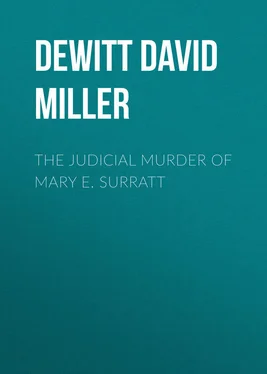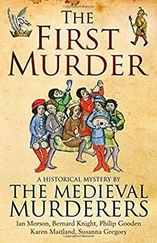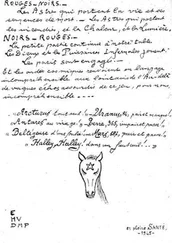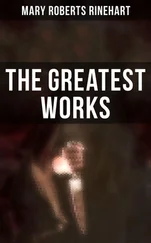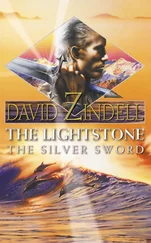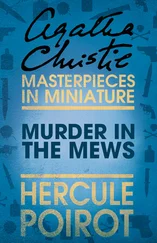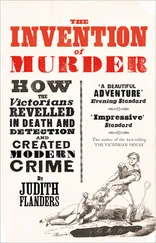David DeWitt - The Judicial Murder of Mary E. Surratt
Здесь есть возможность читать онлайн «David DeWitt - The Judicial Murder of Mary E. Surratt» — ознакомительный отрывок электронной книги совершенно бесплатно, а после прочтения отрывка купить полную версию. В некоторых случаях можно слушать аудио, скачать через торрент в формате fb2 и присутствует краткое содержание. Жанр: foreign_antique, foreign_prose, на английском языке. Описание произведения, (предисловие) а так же отзывы посетителей доступны на портале библиотеки ЛибКат.
- Название:The Judicial Murder of Mary E. Surratt
- Автор:
- Жанр:
- Год:неизвестен
- ISBN:нет данных
- Рейтинг книги:5 / 5. Голосов: 1
-
Избранное:Добавить в избранное
- Отзывы:
-
Ваша оценка:
- 100
- 1
- 2
- 3
- 4
- 5
The Judicial Murder of Mary E. Surratt: краткое содержание, описание и аннотация
Предлагаем к чтению аннотацию, описание, краткое содержание или предисловие (зависит от того, что написал сам автор книги «The Judicial Murder of Mary E. Surratt»). Если вы не нашли необходимую информацию о книге — напишите в комментариях, мы постараемся отыскать её.
The Judicial Murder of Mary E. Surratt — читать онлайн ознакомительный отрывок
Ниже представлен текст книги, разбитый по страницам. Система сохранения места последней прочитанной страницы, позволяет с удобством читать онлайн бесплатно книгу «The Judicial Murder of Mary E. Surratt», без необходимости каждый раз заново искать на чём Вы остановились. Поставьте закладку, и сможете в любой момент перейти на страницу, на которой закончили чтение.
Интервал:
Закладка:
To illustrate how the Bureau of Military Justice dealt with witnesses who happened to have been connected more or less closely with Booth, and who were either reluctant or unable to make satisfactory disclosures, here are two extracts from the evidence given on the trial of John H. Surratt in 1867.
The first is from the testimony of Lloyd, the besotted keeper of the Surratt tavern:
“I was first examined at Bryantown by Colonel Wells. I was next examined by two different persons at the Carroll prison. I did not know either of their names. One was a military officer. I think some of the prisoners described him as Colonel Foster. I saw a man at the conspiracy trial as one of the Judges who looked very much like him. * * * I told him I had made a fuller statement to Colonel Wells than I could possibly do to him under the circumstances, while things were fresh in my memory. His reply was that it was not full enough, and then commenced questioning me whether I had ever heard any person say that something wonderful or something terrible was going to take place. I told him I had never heard anyone say so. Said he I have seen it in the newspapers.
“He jumps up very quick off his seat, as if very mad, and asked me if I knew what I was guilty of. I told him, under the circumstances I did not. He said you are guilty as an accessory to a crime the punishment of which is death. With that I went up stairs to my room.”
The next is from the testimony of Lewis J. Carland, to whom Weichman confessed his remorse after the execution of Mrs. Surratt:
“He [Weichman] said it would have been very different with Mrs. Surratt if he had been let alone; that a statement had been prepared for him, that it was written out for him, and that he was threatened with prosecution as one of the conspirators if he did not swear to it. He said that a detective had been put into Carroll prison with him, and that this man had written out a statement which he said he had made in his sleep, and that he had to swear to that statement.”
Let us add another; it is so short and yet so suggestive. It is from the testimony of James J. Gifford, who was a witness for the prosecution on both trials.
“Q. – Do you know Mr. Weichman?
“A. – I have seen him.
“Q. – Were you in Carroll prison with him?
“A. – Yes, sir.
“Q. – Did he say in your presence that an officer of the government had told him that unless he testified to more than he had already stated they would hang him too?
“A. – I heard the officer tell him so.”
After a fortnight of such wholesale processes of arrest, imprisonment, inquisition, reward and intimidation, the Bureau of Military Justice announced itself ready to prove the charges it had formulated. Thereupon two proclamations were issued by President Johnson. One, dated May the first, after stating that the Attorney General had given his opinion “that all persons implicated in the murder of the late President, Abraham Lincoln, and the attempted assassination of the Hon. William H. Seward, Secretary of State, and in an alleged conspiracy to assassinate other officers of the Federal Government at Washington City, and their aiders and abettors, are subject to the jurisdiction of and legally triable before a Military Commission,” ordered 1st, “that the Assistant Adjutant-General (W. A. Nichols) detail nine competent military officers to serve as a Commission for the trial of said parties, and that the Judge-Advocate-General proceed to prefer charges against said parties for their alleged offences, and bring them to trial before said Military Commission.” 2d, “that Brevet Major-General Hartranft be assigned to duty as Special Provost-Marshal-General for the purpose of said trial and attendance upon said Commission, and the execution of its mandates.”
The other proclamation, dated May 2nd, after reciting that “it appears from evidence in the Bureau of Military Justice, that the atrocious murder of the late President, Abraham Lincoln, and the attempted assassination of the Hon. William H. Seward, Secretary of State, were incited, concerted, and procured by and between Jefferson Davis, late of Richmond, Va., and Jacob Thompson, Clement C. Clay, Beverly Tucker, George N. Sanders, William C. Cleary, and other rebels and traitors against the Government of the United States, harbored in Canada,” offered the following rewards:
“$100,000 for the arrest of Jefferson Davis.
“$25,000 for the arrest of Clement C. Clay.
“$25,000 for the arrest of Jacob Thompson, late of Mississippi.
“$25,000 for the arrest of Geo. N. Saunders.
“$25,000 for the arrest of Beverly Tucker.
“$10,000 for the arrest of Wm. C. Cleary, late clerk of Clement C. Clay.
“The Provost-Marshal-General of the United States is directed to cause a description of said persons, with notice of the above rewards, to be published.”
At this date the President of the defunct Confederacy was a fugitive, without an army; and bands of U. S. Cavalry were already on the scout to intercept his flight. Military Justice, however, was too impatient to await the arrest of the prime object of its sword; and in obedience to the first proclamation proceeded without delay to organize a court to try the prisoners selected from the multitude undergoing confinement as the fittest victims to appease the shade of the murdered President. Over some of the “suspect” the Judge-Advocates for a time vacillated, whether to include them in the indictment or to use them as witnesses; but, after a season of rigid examinations, renewed and revised, they at last concluded that such persons would be more available in the latter capacity.
On the third day of May the funeral car, which, leaving Washington on the twenty-first of April, had borne the body of the lamented Lincoln through State after State, arrived at last at Springfield; and on the following day the cherished remains were there consigned to the tomb. On the sixth, by special order of the Adjutant-General, a Military Commission was appointed to meet at Washington on Monday, the eighth day of May, or as soon thereafter as practicable, “for the trial of David E. Herold, George A. Atzerodt, Lewis Payne, Michael O’Laughlin, Edward Spangler, Samuel Arnold, Mary E. Surratt, Samuel A. Mudd and such other prisoners as may be brought before it, implicated in the murder of the late President and in the attempted assassination of the Secretary of State and in an alleged conspiracy to assassinate other officers of the Federal Government at Washington City, and their aiders and abettors. By order of the President of the United States.” And so, all things being in readiness, let the curtain rise.
PART I.
THE MURDER
CHAPTER I.
The Opening of the Court
On the ninth day of May the Commission met but only to adjourn that the prisoners might employ counsel. On the same day, two of its members, General Cyrus B. Comstock and Colonel Horace Porter – names to be noted for what may have been a heroic refusal – were relieved from the duty of sitting upon the Commission, and two other officers substituted in their stead.
So that Tuesday, May 10th, 1865 – twenty-six days after the assassination, a period much too short for the intense excitement and wild desire for vengeance to subside – may properly be designated as the first session of the Court. On the early morning of that day – before daylight – Jefferson Davis had been captured, and was immediately conducted, not to Washington to stand trial for his alleged complicity in the assassination, but to Fort Monroe. On the next day Clement C. Clay, also, surrendered himself to the United States authorities, and was sent, not to Washington to meet the awful charge formulated against him, but to the same military fortress.
Читать дальшеИнтервал:
Закладка:
Похожие книги на «The Judicial Murder of Mary E. Surratt»
Представляем Вашему вниманию похожие книги на «The Judicial Murder of Mary E. Surratt» списком для выбора. Мы отобрали схожую по названию и смыслу литературу в надежде предоставить читателям больше вариантов отыскать новые, интересные, ещё непрочитанные произведения.
Обсуждение, отзывы о книге «The Judicial Murder of Mary E. Surratt» и просто собственные мнения читателей. Оставьте ваши комментарии, напишите, что Вы думаете о произведении, его смысле или главных героях. Укажите что конкретно понравилось, а что нет, и почему Вы так считаете.
